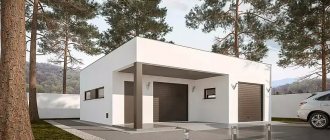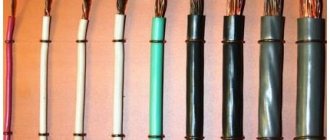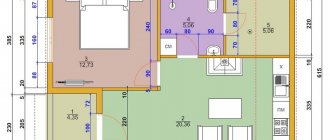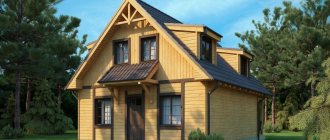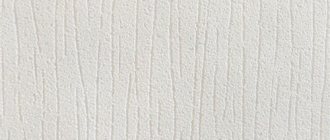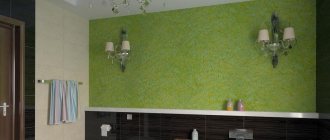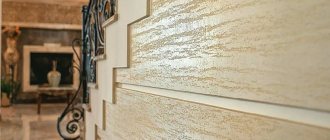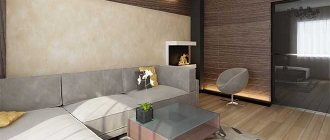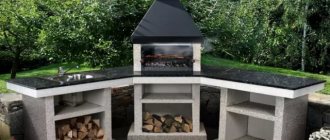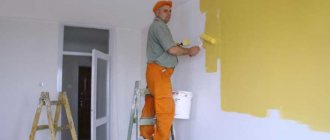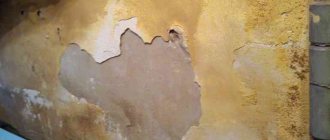Internal and external aerated concrete plaster must have optimal parameters, protecting the walls of the structure from destruction and cracks under the influence of external influences. There are several basic options for finishing mixtures that will improve and maintain the quality of the base. The correct application technology will ensure a long service life and decorative appearance of the coating.
Aerated concrete has good thermal insulation properties and a high degree of vapor permeability due to its porous structure. Proper finishing of aerated concrete will help preserve the quality of the material, preventing the accumulation of condensation and the occurrence of mold.
In this article we will answer the main question, how to plaster aerated concrete outside and inside the house.
Aerated concrete blocks Source sevparitet.ru
Basic requirements for plaster
It is worth noting right away that it is not recommended to apply ordinary plaster to a house made of aerated concrete blocks. Primarily because standard sand solutions are high-density, this leads to poor adhesion when applied to aerated concrete blocks and the rapid appearance of cracks.
Adhesion (from Latin adhaesio - sticking) in physics is the adhesion of the surfaces of dissimilar solids and/or liquids.
The plaster should maintain an optimal microclimate inside the building, protecting the walls from moisture. Therefore, you should choose mixtures with a vapor-permeable base. Otherwise, the steam coming out of the house will get stuck inside the walls, since the plaster will simply block its exit to the outside. Thus, moisture will begin to accumulate in the walls, which will ultimately lead to their destruction. Of course, nothing will happen to the house in a few years, but in six to eight years, an almost irreversible process of destruction will begin.
Plaster for aerated concrete should be:
- resistant to external weather influences;
- have good adhesion (adhesion to aerated concrete);
- resistant to sudden temperature changes;
- high degree of compressive strength (protection against cracking);
- vapor permeable;
- moderately dense;
- improving the thermal insulation of walls;
- have a decorative appearance.
When choosing plaster for aerated concrete, you should not ignore any of the points listed above.
Applying plaster to a house made of aerated concrete blocks Source emupauto.ru
The absence of facade finishing of aerated concrete structures will lead to darkening, deformation, and peeling of the surfaces of the blocks.
Materials
The given recommendations help solve the problem of choosing budget options for interior decoration. Which is better: plaster or drywall? The vapor conductivity coefficient of the densest aerated concrete is 0.16, and the same indicator for gypsum sheets = 0.07, which is more than two times less. Therefore, it is recommended to use plasterboard only in the case of constructing blind vapor barrier external facades; to create a ventilated structure, it is necessary to use plaster mixtures for aerated concrete surfaces inside the house.
With regard to the kitchen, bathroom and toilet in houses made of gas silicate, the question no less often arises: is it possible to lay tiles? The answer is similar: since the vapor conductivity of ceramic products is close to zero, such finishing is permissible with hydrophobic design of the walls on the outside.
Types of plasters suitable for aerated concrete blocks
The choice of plaster mixture for aerated concrete primarily depends on whether you are going to cladding the walls from the outside or from the inside. Based on the type of application, plasters are divided into external and internal.
As you understand, external plaster is intended for finishing facades. Since here it performs protective functions, its strength, moisture resistance and thermal insulation indicators should be higher.
Internal mixtures are intended for finishing indoor walls, so the presence of moisture resistance in the characteristics of these plasters can be ignored, with the exception of cases of wall cladding in the bathroom. Due to the lack of resistance to moisture, internal mixtures are much cheaper than external ones.
Applying a finishing layer of plaster to aerated concrete Source o-cemente.info
Popular plasters for aerated concrete
Mixtures for finishing facades made of aerated blocks are divided according to the type of composition into:
- lime-cement;
- cement thermal insulation (less than 500 kg/m3);
- acrylic;
- silicate;
- silicone.
Lime-cement mortars are quite durable and at the same time vapor-permeable, because their main component is lime, which replaces sand. This type of plaster is popular due to its low cost. So if your task is to make a budget cosmetic repair of the facade or finish the basement, this option is suitable.
Cement heat-insulating (less than 500 kg/m3) mixtures, as a rule, are porous when hardened, lightweight (about 4 kg/m2 with a layer thickness of 10 mm, for comparison, heavy ones can weigh 20-30 kg/m2), and are characterized by high vapor permeability (0.2 ), belong to the class of hydrophobic, weather-resistant and, as a bonus, thermal insulation. This type of mixture is able to protect the house from freezing, blowing, moisture, and the service life of such plaster is comparable to the service life of the entire building. Single-layer cement mixtures for facades are a good solution from the point of view of “sufficiently reasonable” investments and performance characteristics. However, it is necessary to pay attention to the composition, as not all fillers of such mixtures correspond to the declared characteristics and may turn out to be hygroscopic (absorb moisture), which will lead to rapid destruction of the plaster layer. Hygroscopic materials include: perlite, vermiculite. Hydrophobic materials include foam glass and ceramic foam. Of course, the ready-made dry mixture must be of factory origin, comply with GOST 33083-2014, it will be possible to prepare such a composition yourself in a garage, but it will not be possible to achieve high performance characteristics.
an acrylic mixture on the plinth; if you choose it for finishing a facade made of aerated concrete, then be prepared for the fact that in 8-10 years the facade will need to be completely renewed. Since the life of acrylic polymer plaster is maximum 10 years. Such plaster cannot boast of good vapor permeability, moisture resistance and elasticity.
Silicate plaster for aerated concrete is produced on the basis of liquid potassium glass. The coating has good moisture resistance, vapor permeability and durability. The silicate solution is easy to apply. The finishing layer is resistant to dirt and abrasion, providing a decorative finish for a long time (more than 25 years). The problem with silicates is the limited choice of colors.
Leveling walls with silicate plaster Source lineyka.net
Silicone polymer plaster contains acrylic and silicone copolymers. Which make the plaster what it is. The quality characteristics of the material are optimal for creating a durable coating. Silicone plaster has one of the best elastic properties, which ensures the absence of cracks on the surface even when the blocks shrink.
Silicone plaster can undoubtedly be called a leader among others; it has all the most important properties that facade plaster should have, which guarantees you a beautiful and durable facade for many years.
It is not recommended to plaster structures made of aerated blocks using cement-sand mixtures. They do not fit well on the surface of aerated concrete and crack over time.
See also: Catalog of companies that specialize in finishing materials.
Most popular manufacturers
The building materials market is saturated with a huge number of plaster mixtures of various brands for finishing aerated concrete surfaces. Popular compositions have optimal characteristics for the work.
Applying plaster to the interior walls of a house made of aerated blocks Source obustroeno.com
Ceresit CT 24. The mineral composition of the mixture gives the solution plasticity. The material is easy to apply. The coating can withstand up to 100 cycles of low temperature influences. It is recommended to paint after complete drying (after seven days).
CERESIT ST 77. The acrylic type of the mixture is used for facade finishing, ensuring the strength of the coating with a fairly thin layer of application. The material is frost-resistant and resistant to external influences. Used when there is waterproofing and ventilation inside the house.
SPADAR M400 is a cement mixture with the addition of ceramic foam granules, it is a type of single-layer ultra-light plaster mixtures, it is highly decorative, when hardened it is white, according to its technical characteristics it is ideal for plastering walls made of aerated concrete blocks, it is characterized by high adhesion, vapor permeability and does not require priming or the use of reinforcing mesh along the plane of the facade. Weather-resistant, environmentally friendly, non-flammable, durable material.
Founded by Startwell T-21. Cement-lime plaster is frost-resistant and has a sufficient level of adhesion. The resulting coating is resistant to shrinkage and moisture.
Advantages and disadvantages
Gas silicate is often called aerated concrete. This is not entirely correct. The difference between them is insignificant. In aerated concrete, the main binding element is Portland cement, while in aerated silicate it is lime. The second block will appear lighter than the first. There are slight differences in technical specifications. However, they are not of a fundamental nature.
The popularity of gas silicate is explained by a number of its advantages.
- The aerated block has a low price, which can significantly reduce the cost of construction.
- It is light in weight. If you compare gas silicate and concrete blocks of the same size, the first will weigh five times less than the second. This allows you to make a less powerful foundation, and therefore also reduce costs.
- Gas silicate has low thermal conductivity. They are eight times lower than that of brick. Therefore, the material is often used in countries with cold climates.
- It has high soundproofing qualities.
- GSB allows steam to pass through well.
- Gas silicate is safe from an environmental point of view.
- The blocks are produced with strict linear shapes, which speeds up their laying.
